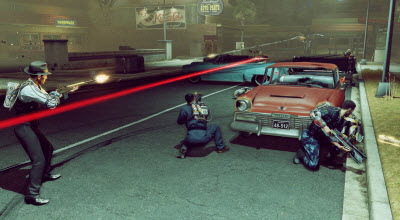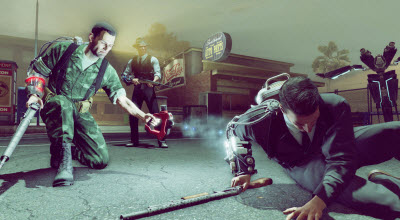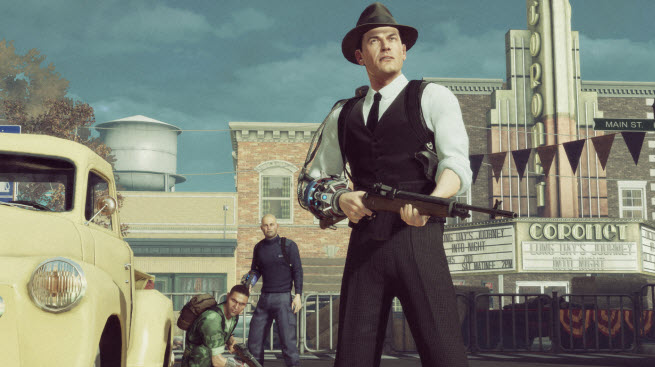During the course of a long development process, The Bureau: XCOM Declassified has morphed from a shooter to a hybrid game that resembles the game play of the Mass Effect series. You can play the title as a shooter, but you won’t get that far if you don’t constantly assign orders to your two squad mates. You can freeze the action and assign your squad to outflank the enemy. That adds elements of a role-playing game and a squad-based tactical shooter game.

But it certainly isn’t the first-person shooter that everybody thought it would be when Take-Two Interactive‘s 2K Games division announced it a couple of years ago. We saw that clearly in a recent hands-on preview of the game. The game has gone through a big pivot, and it is moving away from the crowd that expects a Halo-like combat experience. It’s definitely not a run-and-gun game, said Alyssa Finley, vice president of product development at 2K Marin, in an interview with GamesBeat.
The previous preview in 2010 “hit a lot of the XCOM beats but the one it didn’t show was the interplay between you and your team,” Finley said. “That’s a key part of the XCOM experience.”
Getting to know XCOM again
The game series known as X-COM (yes, it had a different spelling) is a beloved one for gamers. The sci-fi game series dates back to 1994 with UFO: Enemy Unknown (Mythos Games and MicroProse) and 1995 with X-COM: Terror from the Deep (MicroProse). In the series, the Earth’s defenders capture enough of the invaders’ technology to turn it against them. The series hit a low point after Hasbro acquired MicroProse in 1998 and published the poorly received X-COM Enforcer in 2001. Two other X-COM games were canceled, so there was a lot of pent-up demand when Sid Meier’s Firaxis Games team revived the franchise with XCOM: Enemy Unknown in 2012.
2K Marin has been working on the title since it shipped BioShock 2 and BioShock 2: Minerva’s Den. But the game isn’t like those titles at all. The game resembles Mass Effect in a lot of ways. If you liked Mass Effect, then you’ll understand the controls pretty easily. And if this title succeeds, it will give further momentum to the revival of the XCOM brand that started with Enemy Unknown.
“In that game, you were the commander and did not put yourself at risk,” she said. “But what we are trying to add to that is that feeling of having your personal stake in the battlefield. You had to plan for your team and be responsible for these two other guys. But you also had bullets in the game yourself.”
 That way, you get to bring your own skill to the party. As for the similarity to Mass Effect, Finley said, “Absolutely. It’s a great game. We are trying to provide the kind of narrative hub that you see in Mass Effect, where you can go and talk to people and see the progression of the war from the home front view. We also have the command wheel where you can get a sense of everybody’s powers. But the thing we are trying to push on is to be the commander of your team and build fairly complicated plans that you can queue up and execute on in the field.”
That way, you get to bring your own skill to the party. As for the similarity to Mass Effect, Finley said, “Absolutely. It’s a great game. We are trying to provide the kind of narrative hub that you see in Mass Effect, where you can go and talk to people and see the progression of the war from the home front view. We also have the command wheel where you can get a sense of everybody’s powers. But the thing we are trying to push on is to be the commander of your team and build fairly complicated plans that you can queue up and execute on in the field.”
On the other hand, Finley said, “We are not trying to make a Mass Effect clone.”
Battle Focus controls
2K Marin’s Finley compared the new game to a cross between a third-person shooter game and the Enemy Unknown turn-based shooter game. When Enemy Unknown allowed you to see the battlefield from above, The Bureau puts you in the shoes of the squad commander. You have to give commands in real-time to the computer-controlled teammates using a function dubbed Battle Focus.
When you tap the button for it, you called up a command wheel for both of your squad mates. You can move to points along the wheel and stop on one point to issue a command. Those commands include things like covering fire, assigning targets, and using special abilities such as deploying a sentry gun or laying a mine. It’s a lot like Rainbow Six, in terms of squad combat. Of course, sending out three lightly armed federal agents against an alien threat might seem a little understaffed. But Finley said the designers didn’t want the game to be too complicated. Also, the point is to make you feel connected to the other squad members on an emotional level.
The team also shifted the time of the story from a “Norman Rockwell style 1950s” art to the edgy, paranoid time of the 1960s, Finley said. That meant the art style was also more realistic. At the same time, it kept the tradition of having colorful alien creatures. The graphics are reminiscent of the Route 66 imagery of the 1950s and early 1960s. They’re stylized, sort of like a Film Noir movie, but with a lot more color.

A real character and story
During the course of the game, you have to handle squad management, light base management, alien-technology research, and more. But, unlike Enemy Unknown, the game will have a deep story built around the intelligence agent William Carter. Carter is an agent whose career is in a tailspin. He drinks too much, but he just happens to be in the right spot to witness and deal with the enemy aliens as they first attack the country.
Set in 1962, Carter stumbles headlong into an alien invasion of Earth. But it is in the midst of the Cold War, and the American government wants to keep the invasion a secret in hopes of avoiding a nuclear war with the Soviet Union.
To deal with the invasion, the U.S. government creates an agency called The Bureau, which eventually evolves into the XCOM organization. At first, the super-secret organization was created to deal with the Communist menace. But it has been rechristened. In the operations center, you can see a bunch of red dots on the map of the U.S. All of those spots are places where the aliens have landed. The game is non-linear in that you can pursue any of the missions on the map. Some of the missions are urgent, like an assignment to stop a missile launch in Great Falls, Montana. Some missions are passive, where you just send an agent to investigate. As the war against the aliens proceeds, you can see your progress on the strategic map.
The organization’s job is to hide the dangerous truth of the aliens, which could spark a mass panic or even a Russian invasion. But the invaders don’t go along with this, and they quietly take over small towns across the U.S. The agents try to stamp out those fires. Each effort to do so is considered a mission, and you have to take a squad to each location to stamp out the effort.
You can level up the capabilities of your comrades as you go. You’ll have a bunch of comrades to choose from, and you can view their capabilities before you assign them to missions.
If you send them to their deaths, you’ll feel bad. But it’s worst than that. If they die, your colleagues are permanently gone. In that case, you have to get a substitute player and start over with the leveling up. That means you have to be careful about placing your teams in danger. That means you’ll have to think through the best way to handle an enemy. And, hint, the frontal assault isn’t always the answer.
At some point, you’re going to run into tougher enemies, Finley said, and you may not have enough weaponry and skills to take them on. That’s where’s it’s going to matter which missions you do, and how many of them you take on, before you try to move to the big-time battles.

